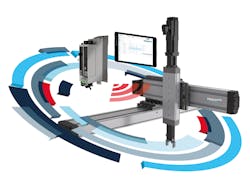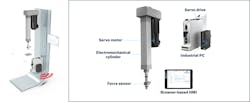The Next Level of Mechatronics Paves the Way to the Factory of the Future
Mechatronic systems are essential in today’s modern assembly production environment. The integration of linear motion components, electronic controls, software, electric motors, and sensors provide a versatile toolbox for machine builders.
Assembly operations that use joining and pressing tools for a wide range of production applications are, like many manufacturers, seeking to improve the versatility, ease of use, and performance of their production tools. They are seeking mechatronic systems that take advantage of the latest developments in both hardware and software to help improve precision and quality of the parts they produce.
At the same time, they also seek to add Industry 4.0 capabilities to their operations and production platforms. This includes taking advantage of enhanced tracking of data about each machine’s production, including simple yet efficient ways to share that information—in real time, if possible—with higher-level production analytical systems to improve their overall operations.
As assembly operations begin to embrace the benefits of Industry 4.0 technology, a new concept called “smart mechatronics” has evolved, offering more intelligence, sophistication, and functionality in pressing and joining, while also being easier to specify, order, and deploy.
Current and Emerging Pressing and Joining Challenges
Manufacturers that make wide use of pressing and joining applications in their production are seeking ways to leverage Industry 4.0 technology to boost their productivity and keep their pressing and joining tools in line with the rest of their manufacturing platforms.
Through smart, well-engineered integration of linear components and electronic motors, controls, and sensors, mechatronics makes it easier for OEMs that supply tools to the pressing and joining industry to quickly build efficient, high-performance manufacturing systems.
In some ways, mechatronic systems could even be considered a forerunner of Industry 4.0 technology: combining disparate mechanical and electronic components into solutions dedicated to specific product assembly and transport tasks, such as Cartesian robots and forming and crimping tools.
The smart mechatronics concept builds on that value, creating manufacturing systems with features such as advanced sensors and operator-friendly tools that do not require sophisticated motion control programming ability and are able to yield real-time data for system performance and manufacturing quality.
Machine builders and end-users want precise control and execution of motion sequences, but also automated tracking of production data and easy connectivity with machine-level and plantwide production management systems.
There is also a demand for greater versatility and easier, faster changeovers: Many pressing and joining production lines or mid-size shops seek tools that make it easy to produce a wide range of batch sizes, from the low end of only a few thousand parts up to hundreds of thousands, without requiring extensive effort to re-program tools for a new part.
From Integrating Components to “Plug and Produce”
At one time, mechatronics pressing and joining tools had to be integrated with components coming from multiple suppliers: drives and motors from one company, mechanical components like electromechanical cylinders from another, controllers or industrial PCs to run the machine from someone else, plus all the requisite cabling and power supply devices.
Leading mechatronics suppliers are replacing that time-consuming acquisition and integration step with complete solutions that are literally “plug and produce”: complete systems with all the electronics, mechanical components, sensors, cabling, communications interfaces, and drive and control components, including software that is pre-programmed and delivered as a single production tool.
To streamline how these plug-and-produce mechatronics solutions are specified, configured, and purchased, a new generation of online tools are being deployed. These tools are designed to make it easier for engineers that have just a basic understanding of linear motion and controls requirements to create a complete solution.
Following sizing and configurator prompts, all the components for a complete mechatronic solution—a Cartesian robot or a pressing or joining tool—can be specified in a single process. Users can enter parameters such as stroke, workpiece weight, and cycle time which then generates an output that can be verified in the CAD environment.
Faster, More Intuitive, More Intelligent Production
Easier, faster commissioning is one major advance provided by the new smart mechatronic systems and the technology that supports it. Equally valuable is the improved efficiency, flexibility, and productivity it is providing for assembly operations that incorporate joining and pressing applications.
Bosch Rexroth recently introduced a smart mechatronic solution for pressing and joining applications that demonstrates the plug-and-produce model. The Smart Function Kit for Pressing combines all the hardware and software into a single solution to support a wide range of pressing and joining assembly operations.
It's delivered with preinstalled operating software and automatic parameterization of the servo drive, so no motion control programming knowledge is needed. It features a drag-and-drop graphical user interface that lets operators build production sequences—e.g., for a function such as pressing ball bearings into a housing— simply and intuitively.
Standard sensors such as a force sensor in the mechatronics system measure and track its operation. For example, in a bearing press application, the linear motion actuator moves in precisely controlled sequences with the exact force to insert each ball bearing into the housing.
As this sequence is typically repeated hundreds or even thousands of times per hour, the system’s controller can measure and record each motion cycle for quality control purposes. Operators can use tools that are part of the software package to create visualizations of the process results and analyze force-displacement curves in real time at their workstations.
Smart Mechatronics Deliver Real-World Benefits
Manufacturers that use joining and pressing machines are taking advantage of the flexibility and ease of use the latest smart mechatronic systems offer. Recently, a leading sensor manufacturer was setting up a new production line, one designed to produce small batches with exact pressing and joining processes. The company chose the Rexroth Smart Function Kit for Pressing, delivered as a preconfigured complete package with minimal programming required, so the sensor manufacturer was able to set up the new production line in record time.
A key production step is pressing a small lid precisely onto the sensor housing. Programming this process can now be done by an operator— no specialized skills are required. Software blocks are selected and combined via a drag-and-drop programming style, the process parameters are entered, and the workflow is complete.
Check out more of Bosch Rexroth's smart solutions for the factory here.
In addition, the process data can be shown live and the force-displacement curves are recorded each time a lid is placed for quality assurance and analysis. The mechatronic system has already saved the sensor manufacturer time as well as improved its ability to implement small-batch assembly operations.
Advancing Pressing and Joining Applications
Smart mechatronic technology has the potential to elevate pressing and joining systems to new levels of flexibility and sophistication— especially those engineered to deliver “plug-and-produce” performance. Mechatronic assembly tools that provide all system components from one manufacturer, pre-programmed and ready to configure and begin operation upon delivery, offer the fastest return on investment for manufacturers. Platforms that also feature drag-and-drop programming of motion sequences, as well as real-time visualization and recording of force curves, can help ensure improved quality, faster changeovers, and more productive pressing and joining processes.
Smart Press Kit:
Designed to meet future industry requirements and providing a complete mechatronics package that is immediately ready for use across a wide range of pressing and joining applications, the modular Smart Press Kit consists of mechanical components, electrical components, and software—simplifying product selection and configuration as well as commissioning. The Smart Press Kit can be connected via open interfaces and conveniently monitored on a tablet during operations to maximize transparency, reduce downtime, and increases productivity.
This easy and fast solution is specially designed for pressing and joining processes in the low force range of 2 to 30 kN. The modular system consists of perfectly synchronized hardware and software components: an electromechanical cylinder and d power sensor, servomotor, drive controller, industrial PC, and browser-based HMI software based on HTML 5.
Features:
- The system consists of cylinder mechanics, regulator, control system, and software to set up automatic program sequences for pressing and joining processes
- Web-based software allows you to set up sequence programs by way of drag-and-drop movement profile building blocks
- The function of the system: Controlling the position of the piston rod while monitoring the force
- The recording of the force/route allows its evaluation through envelope graphs
- The recording data is available after the program sequence
- Can be used as a stand-alone solution or integrated into higher-level systems via fieldbus or OPC-UA
Applications:
- Press-fitting bearings in housings
- Crimping cables and hoses
- Inserting (for example, integration of magnets in lamination stacks)
- Forming processes (embossing and deep drawing in the plastics industry)
- Measurement
- Test procedures/test stands



